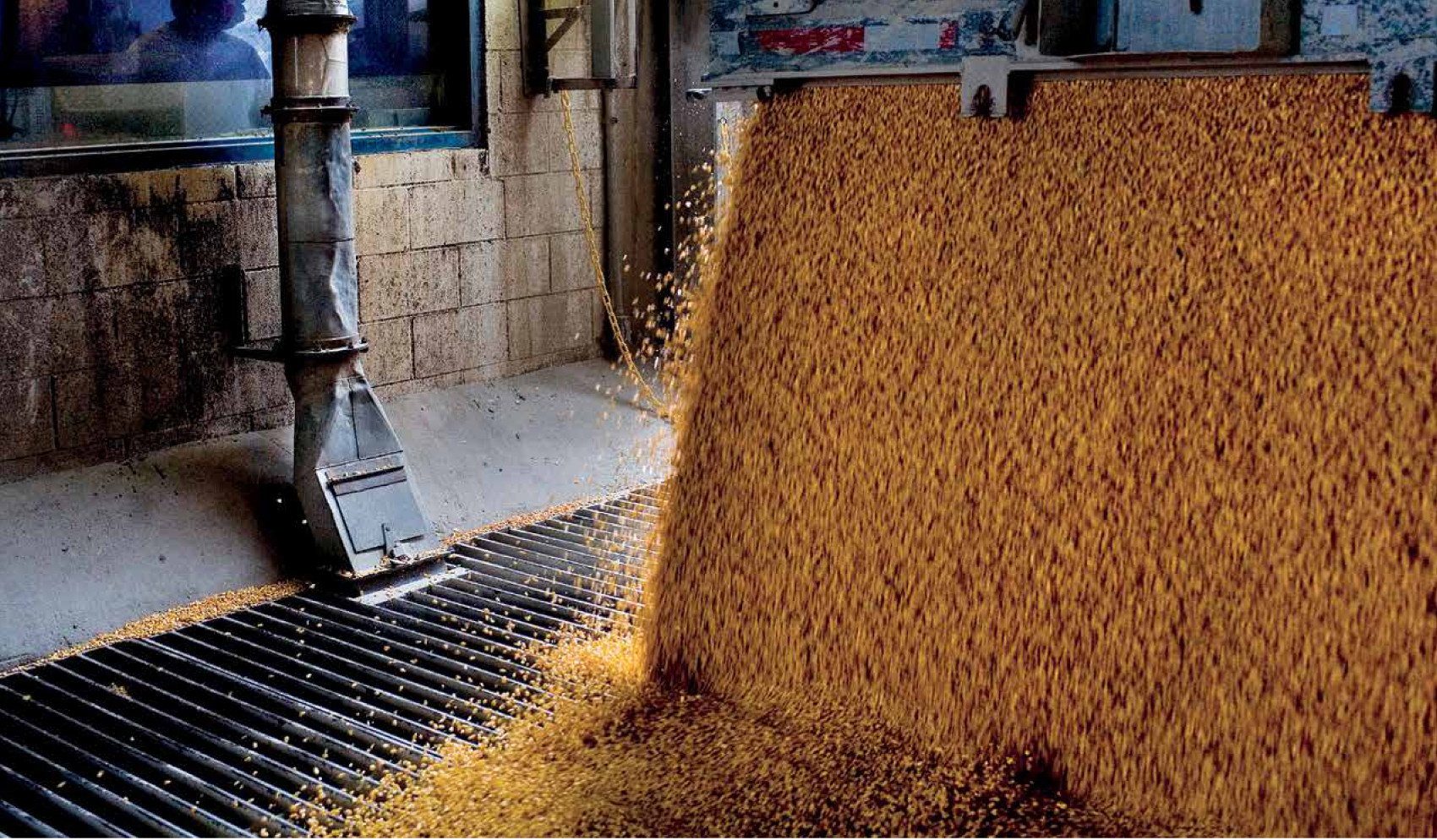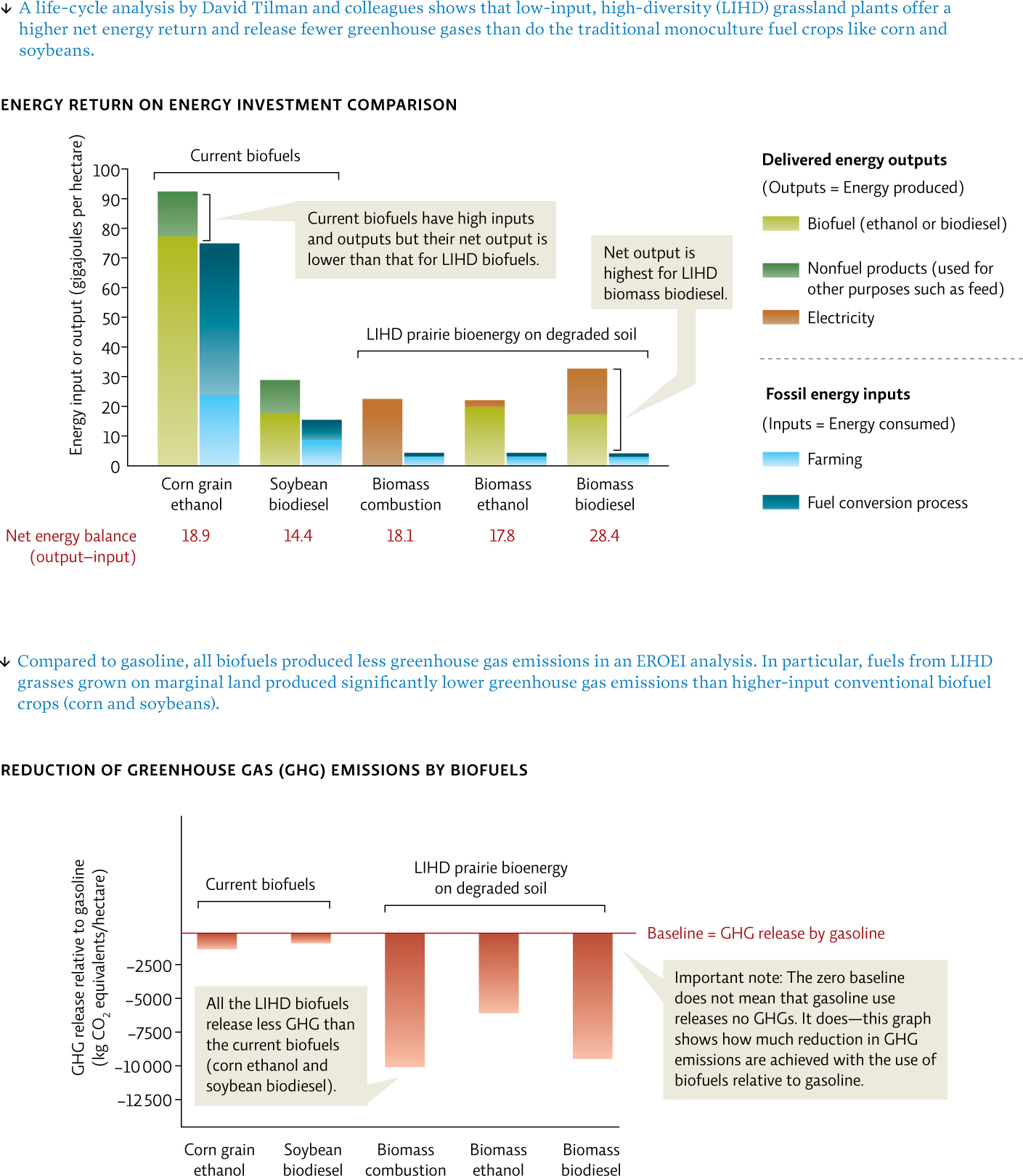25.5 Tilman’s experiments showed the importance of biodiversity.
Every August for 10 years, as part of their ongoing quest to understand why plants growing in the most diverse areas could more easily weather periods of drought, Tilman’s team spread out and harvested small strips of vegetation from each plot. They dried and weighed the plants, determining how much biomass—in this case, plant material—had grown. The results floored them.
461

“Frankly, we never imagined the effects of diversity would be as large as they turned out to be,” says Tilman. The biomass analysis showed that plots with 16 species of plants were an average of 238% more productive than fields planted with only one species (monoculture). In a way, this was not a surprise—ecologists have found that plants often grow better together than by themselves because their differences can complement each other. For example, one species may shed its leaves in the late spring, depositing valuable nutrients into the soil that another species takes up in the summer. Ecological communities with high species diversity such as these arose over time as individuals competed for resources. This led to resource partitioning—each species uses particular resources and is very efficient at accessing and using those resources. Species diversity also leads to mutualistic and commensal relationships, all of which maximize energy uptake and nutrient flow in the community, increasing overall biomass (see Chapter 8).
Tilman kept thinking about the results—specifically, about how they could model biofuel crops after what nature had already figured out: biodiverse ecosystems that are naturally adapted to their environment are the most productive.
Ethanol is easily made from the starch in corn, but it can also be derived from cellulose, a compound that forms in the cell walls of all plants and makes up the bulk of the fibrous structure of a plant like switchgrass. Like with other forms of biofuels, people had been trying to produce fuel from cellulosic material such as wood for decades.
Recently, cellulosic ethanol that can be produced from crops such as switchgrass has become a popular alternative to corn ethanol. For starters, it has the potential to circumvent the food controversy, since it doesn’t have to occupy land that could support food crops. Additionally, switchgrass is resistant to many pests and plant diseases and requires little fertilization, so it consumes less energy to produce. Even more attractive to alternative energy aficionados, switchgrass, like other plants, absorbs CO2 from the atmosphere and stores carbon in its roots, a process called carbon sequestration. By working with a perennial like switchgrass instead of an annual like corn, much of the plant (and its carbon) would remain behind in the deep root system, ready to grow again immediately after harvesting.
462
463
However, people who mentioned switchgrass as a source of biofuels “were always talking about monocultures,” Tilman remembers, and growing switchgrass as a crop by itself. Tilman realized that by growing switchgrass in high-diversity mixtures of many plant species, a plot could produce a lot more biomass with the same or smaller amounts of irrigation, fertilizer, and management. That meant more biofuel for fewer inputs.
“We kept saying, ‘we gotta tell people about this!’” Tilman recalls. To do so, he hired Jason Hill, then an assistant professor of biology at St. Olaf College in Minnesota. Hill collected Tilman’s biomass data for each plot over the 10 years, as well as the recorded levels of carbon in the soil and roots of the plants, and analyzed the net energy that could be produced from the grasslands. He compared those data to the amounts of energy harvested from corn and soybeans. The results were overwhelming: the 16-species plots were not only capable of producing more bioenergy than monocultures, they sequestered 14 times more carbon in the soil than the amount released by growing and processing the crop into a biofuel. In other words, they made the grasslands carbon negative—they stored more carbon than was released to grow or use the fuel. Finally, Hill and Tilman noted that diverse grasses can be grown on neglected agricultural lands and in marginal soil, therefore not displacing food production or destroying habitats. The two researchers published their results in a 2006 issue of Science, demonstrating for the first time the feasibility and potential of biofuels from low-input, high-diversity grasslands, called LIHD biofuels. [infographic 25.4]

“When you have a new idea, you start imagining what might happen, but you never know what will really happen until you try the experiment.”
—David Tilman
The media went crazy: “Wild flowers could provide a solution to global warming,” hailed a Scottish newspaper; “It sounds too good to be true,” wrote a journalist at Discovery News. Unfortunately, that’s exactly what some other scientists thought of Tilman’s conclusions—too good to be true.
Criticism came swiftly, and from close to home. In the building next door to Tilman’s at the University of Minnesota, members of the United States Department of Agriculture (USDA) and professors in the University’s agronomy department began to discuss their concerns about Tilman’s paper. Michael Russelle, a USDA soil scientist and adjunct professor at the university, suspected that Tilman’s group had overestimated the carbon sequestration of the grasslands because of the way they managed the plots—by burning the plots at the end of the season after estimating productivity, they potentially left behind more carbon than harvesting would have done. Because of this, Russelle felt that the energy accounting was “misleading.”
“Many issues have rapid political implications, and this is one of those. In this case, we felt that the paper wasn’t warranted by the data, so we just felt it had to be challenged,” recalls Russelle. He approached Tilman and Hill to inform them that he and colleagues were planning to write a rebuttal (an official commentary in response to Tilman’s paper). Tilman and Hill were surprised but accommodating. “It’s good to have a public dialogue over a controversial paper,” says Hill. “You just don’t necessarily expect it to come from the building next to you,” he adds with a laugh.
The three men met for coffee, but by the end of the meeting, they remained divided. “They didn’t convince me,” says Russelle. The dissenters published their comment in Science, but Tilman and Hill didn’t back down, and published a response, backing up their results and study design with other published research. “We essentially said we appreciate your concerns, but we do not think they changed the outcome of the conclusions at all,” says Hill.
Today, the two groups still maintain opposing view-points, but both recognize the importance of the dialogue. “Science is a continual process of putting forth a hypothesis, testing it, evaluating the results, and moving forward,” says Russelle.